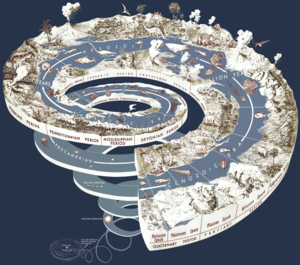Last year Earth Pages News reported a rationalisation of the way in which geological time is signified (Rationalising geological time 7 May 2011). A working group set up by the International Union of Pure and Applied Chemistry (IUPAC) and the International Union of Geological Sciences (IUGS) defined the year as the base unit, standardizing it to the time in seconds between one solstice and the next at the equator for year 2000 (3.1556925445 × 107 s) thereby linking it to the Système international d’unités or SI base unit of the second, itself defined in terms of behaviour of the caesium atom. It is to be signified by ‘a’ for annus (year in Latin) and preceded by ‘k’, ‘M’ and ‘G’ for thousands, millions and billion years, complying with the SI progression in steps of 103 for units.
The sticking point for some, mainly in the US (e.g. Science magazine and many geoscientists there) is that the ka, Ma, Ga symbols are to apply not only to times before the present but also to spans of geological time. Since the agreed convention is incorporated into SI it has almost the force of law for scientists , so that the Cretaceous Period will be said to have begun at 145.5±4.0 Ma ago, ended at 65.5±0.3 Ma ago and was 80 Ma long, instead of the latter being in m.y., m.yr., mya or Myr according to what seem to have been personal quirks or those of scientific journals.
Somewhat florid reaction against the rationalisation (Christie-Blick, N. 2012 Geological time conventions and symbols. GSA Today, v. 22 (February 2012 issue), p. 28) seems to have flowed from a deliberation on the IUPAC-IUGS proposal (in Prague, Spring 2010) by a lesser world body: the International Commission on Stratigraphy’s (ICS) International Subcommission on Stratigraphic Classification (ISSC). The meeting voted 16 to 2 to reject the proposal – a substantial number of voting members abstained – claiming that it violated SI ‘rules’ regarding base- and derived units. The issue, on reaching the ICS meeting, as the same Prague workshop, seems to have been greeted by a 50:50 split. A closed meeting of the ICS Bureau (now we can begin to see the kind of thinking involved here…) on the workshop’s last day unanimously adopted the motion ‘We neither accept nor reject the IUGS-IUPAC Task Group’s recommendation to apply Ma, generally, as the unit of deep time. We accept the argument for Ma as a single unit for time but would recommend flexibility, allowing for the retention of Ma as specific notation for points in time (i.e., dates) and myr as a unit of time denoting duration. We agree with the spirit of this statement’ [my italics]. ‘Neither accepting nor rejecting’ is something familiar from minutes of the Central Committee of the former USSR, being rumoured to have been Joseph Vissarionovich Stalin’s favoured formulation in moments of uncertainty: a little like the old ‘Belfast Question’, ‘Are you for us or against us’ from someone whose politics is not entirely clear.
An argument proffered by Christie-Blick is, ‘No one objects to the storming of the Bastille on 14 July 1789 (a date) or to the construction of Stonehenge from 2600–1600 BC (an interval specified by two dates). In the case of the latter, we say that the job took 1000 years, not 1000 BC.’ This forgets something quite practical: geochronologist rarely if ever, ‘neither accept nor reject’ AD, BC BCE, or CE but express time in years before present, with the odd convention that ‘the present’ was 1950, before atmospheric testing of thermonuclear devices. What is wrong with the answer to the question, ‘When did the Cretaceous begin?’ being 145.5 Ma ago, or ‘80 Ma’ in answer to, ‘How long did it last?’ Who would prefer the alternative to the second question – 80 (choose your preferred symbol from the following: m.y., m.yr., mya. Myr., million years or millions of years)?
Related articles
- How To: Build a geologic time spiral cake (boingboing.net)
- Prehistory Notebook Pages – Primary (awakeningwonder.wordpress.com)





















